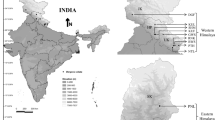Abstract
The present study aimed to reveal genetic diversity and population structure in three Onosma species i.e., Onosma bulbotrichum DC., O. elwendicum Wettst. and O. sericeum Willd. (Boraginaceae) growing in Iran. This study was performed to check if the ISSR molecular markers could be used in the Onosma species delimitation. We also investigated the infra-specific morphological variability and if we can identify infra-species taxonomic forms. The present study revealed within species genetic and morphological diversity. ISSR data could delimit the studied species as they were separated from each other in NJ tree, maximum parsimony and STRUCTURE analysis. AMOVA and Hickory tests produced significant genetic difference among the studied species. The Mantel test showed no correlation between genetic distance and geographical distance of the populations for all three species. Reticulation analysis and Nm estimation showed gene flow among these populations. We could identify a few ISSR loci that are adaptive. Data obtained can be used in conservation of these medicinal plants in Iran.
Similar content being viewed by others
References
Badruddeen R., Sheeba., Hefazat H., Haque S.E., Khalid M. & Akhtar J. 2012. Psychoimmunomudellatory effects of Onosma bracteatum Wall. (Gaozaban) on stress model in Sprague Dawley rats. J. Clinic. Diag. Res. 6: 1356–1360.
Felsenstein J. 1989. PHYLIP - Phylogeny Inference Package (version 3.2). Cladistics 5: 164–166.
Falush D., Stephens M. & Pritchard J.K. 2007. Inference of population structure using multilocus genotype data: dominant markers and null alleles. Mol. Ecol. Notes 7: 574–578.
Frichot E., Schoville S.D., Bouchard G. & Francois O. 2013. Testing for Associations between Loci and Environmental gradients using latent factor mixed models. Mol. Biol. Evol. 30: 1687–1699.
Gohari A.R., Saeidneya S., Gohari M.R., Moradi-Afrapoli F., Malmir M., Yazdanpanah M. & Hajiakhoondi A. 2009. Study of the cytotoxic effects of some medicinal plants in Lami-aceae, Asteraceae, Boraginaceaea and Rosaceae on the larva of Artemia salina. J. Med. Plants 29: 87–93.
Hammer Ø., Harper D.A.T. & Ryan P.D. 2012. “PAST: Paleon-tological Statistics software package for education and data analysis. Palaeont. Elect. 4: 9.
Holsinger K.E. & Lewis P.O. 2003. Hickory: a package for analysis of population genetic data V1.0. Available at http://www.eeb.uconn.edu; Accessed 2003.
Khatamsaz M. 2002. Flora of Iran (in Farsi), Tehran, Research Institute of Forests and Rangelands.
Kolarčik V., Zozomová-Lihová J. & Mártonfi P. 2010. Systemat-ics and evolutionary history of the Asterotricha group of the genus Onosma (Boraginaceae) in central and southern Europe inferred from AFLP and nrDNA ITS data. Plant Syst. Evol. 290: 21–45.
Kolarčik V., Zozomová-Lihová J., Erik Ducár E. & Mártonfi P. 2014. Evolutionary significance of hybridization in Onosma (Boraginaceae): analyses of stabilized hemisexual odd poly-ploids and recent sterile hybrids. Biol. J. Linn. Soci. 112: 89–107.
Križman M., Jakse J., Baricevic D., Javornik B. & Prošek M. 2006. Robust CTAB activated charcoal protocol for plant DNA extraction. Acta Agri. Sloven. 87: 427–433.
Legendre P. & Makarenkov V. 2002. Reconstruction of biogeo-graphic and evolutionary networks using reticulograms. Syst. Biol. 51: 199–216.
Makarenkov V. & Lapointe F.J. 2004. A weighted least-squares approach for inferring phylogenies from incomplete distance matrices. Bioinformatics 20: 2113–2121.
Mehrabian A.M., Sheidai M., Noormohammadi Z., Mozafarian V. & Asrei Y. 2012. Palynological diversity in the genus Onosma L. (Boraginaceae) of Iran. Ann. Biol. Res. 3: 3885–3893.
Mehrabian A.R., Sheidai M., Noormohammadi Z., Asrei Y. & Mozafarian V. 2011. Inter-simple sequence repeats (ISSR) and morphological diversity in Onosma L. (Boraginaceae) species in Iran. Afr. J. Biotechnol. 10: 10831–10838.
Mengoni A., Selvi F., Cusimano N., Galardi F. & Gonnelli C. 2006. Genetic diversity inferred from AFLP fingerprinting in populations of Onosma echioides (Boraginaceae) from serpentine and calcareous soils. Plant Biosyst. 140: 211–219.
Peakall R. & Smouse P.E. 2006. GENALEX 6: genetic analysis in Excel. Population genetic software for teaching and research. Mol. Ecol. Notes 6: 288–295.
Podani J. 2000: Introduction to the Exploration of Multivariate Data (English translation), Leide, Netherlands, Backhuyes.
Perrier X. & Jacquemoud-Collet J.P. 2006. DARwin software version 5·0·155. CIRAD: http://darwin.cirad.fr/darwin.
Pritchard J.K., Stephens M. & Donnelly P. 2000. Inference of population structure using multilocus genotype data. Genetics 155: 945–959.
Sheidai M., Seif E., Nouroozi M. & Noormohammadi Z. 2012. Cy-togenetic and molecular diversity of Cirsium arvense (Aster-aceae) populations in Iran. J. Jpn. Bot. 87: 193–205.
Sheidai M., Zanganeh S., Haji-Ramezanali R., Nouroozi M., Noormohammadi Z. & Ghsemzadeh-Baraki S. 2013. Genetic diversity and population structure in four Cirsium (Aster-aceae) species. Biologia 68: 384–397.
Stebbins G.L. 1993. Concepts of species and genera in flora of North America, pp. 229–246. In: Flora of North America, vol. 1. New York: Oxford University Press.
Şuteu D., Popescu F., & Popescu O. 2007. Genetic diversity evaluation of the species Onosma sp. (Boraginaceae). Ann. West Univ. Timisoara Ser. Chem. 16: 45–54.
Şuteu D., Băcilă I., Ursu T. & Coldea G. 2012. Genetic diversity assessment of the Romanian populations of Onosma pseu-doarenaria and Onosma arenaria. Contributii Botanice 47: 49–57.
Tosun A., Akkol E. K., Bahadir O. & Yeşilada E. 2008. Evaluation of anti-inflammatory and antinociceptive activities of some Onosma L. species growing in Turkey. J. Ethnopharmacol. 120: 378–381.
Weising K., Nybom H., Wolff K. & Kahl G. 2005. DNA Fingerprinting in Plants: Principles, Methods, and Applications. Boca Rayton, Fl., USA, CRC Press, 472 pp.
Yeh F.C. & Boyle T.J.B. 1997. Population genetic analysis of co-dominant and dominant markers and quantitative traits. Belgian J. Bot. 129: 157
Author information
Authors and Affiliations
Corresponding author
Rights and permissions
About this article
Cite this article
Sheidai, M., Sadeghi, S., Ameri, MA. et al. Species delimitation and population structure in three Onosma (Boraginaceae) species. Biologia 70, 1326–1333 (2015). https://doi.org/10.1515/biolog-2015-0151
Received:
Accepted:
Published:
Issue Date:
DOI: https://doi.org/10.1515/biolog-2015-0151




